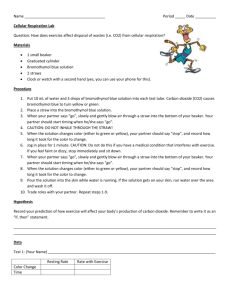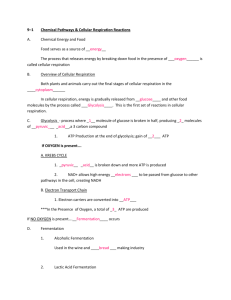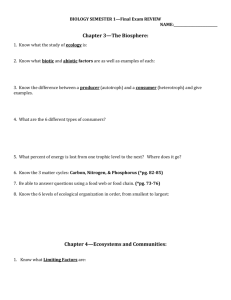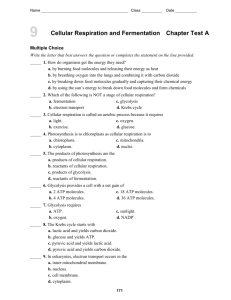CherryDch9notes
advertisement
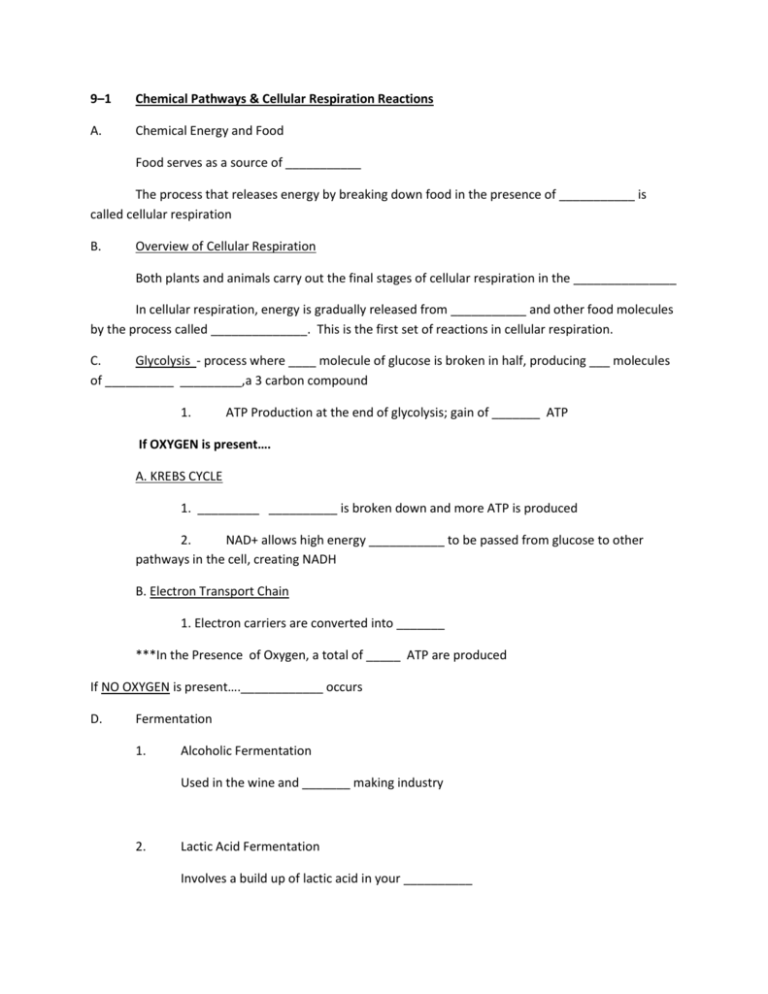
9–1 Chemical Pathways & Cellular Respiration Reactions A. Chemical Energy and Food Food serves as a source of ___________ The process that releases energy by breaking down food in the presence of ___________ is called cellular respiration B. Overview of Cellular Respiration Both plants and animals carry out the final stages of cellular respiration in the _______________ In cellular respiration, energy is gradually released from ___________ and other food molecules by the process called ______________. This is the first set of reactions in cellular respiration. C. Glycolysis - process where ____ molecule of glucose is broken in half, producing ___ molecules of __________ _________,a 3 carbon compound 1. ATP Production at the end of glycolysis; gain of _______ ATP If OXYGEN is present…. A. KREBS CYCLE 1. _________ __________ is broken down and more ATP is produced 2. NAD+ allows high energy ___________ to be passed from glucose to other pathways in the cell, creating NADH B. Electron Transport Chain 1. Electron carriers are converted into _______ ***In the Presence of Oxygen, a total of _____ ATP are produced If NO OXYGEN is present….____________ occurs D. Fermentation 1. Alcoholic Fermentation Used in the wine and _______ making industry 2. Lactic Acid Fermentation Involves a build up of lactic acid in your __________ In fermentation, not as much energy is produced; a total of ___ ATP Fermentation is an _____________________ process where NADH is able to be converted back to _________ by passing high energy electrons back to pyruvic acid. This allows a steady supply of ______ to be produced in the absence of __________ Label the following diagram using your textbook ch 9 1. Where does the glucose used in respiration come from? 2. How do you know that this series of reactions occurs in the present of oxygen? 3. What does glycolysis supply to the Krebs cycle? 4. What does glycolysis supply to the electron transport chain? 5. What stages of cellular respiration occur in the mitochondria? Label the following concept map of cellular respiration pathways using your text List the following equations: 1. Chemical & written equation for cellular respiration 2. written equation for lactic acid fermentation 3. Written equation for alcoholic fermentation 4. 9–2 The Krebs Cycle and Electron Transport A. The Krebs Cycle In the Krebs cycle, ________ ______ is broken down into _____ _________ and is also known as _________ acid cycle The krebs cycle begins when the pyruvic acid produced from glycolysis enters the ___________ Carbon Dioxide is formed and ___________ into the atmosphere and _______________ is formed wich produces a 6 carbon molecule called ________ __________ Everytime you exhale, you release __________ ___________ produced by the ___________ cycle. The ______ Produced can be used to perform cellular activies B. Electron Transport 1. Uses high energy electrons from __________ and _________ in the __________membrane of the mitochondria in a process called the _______________ transport ___________. 2. at the end of the electron transport chain, oxygen is the final electron acceptor which forms _________ to get rid of the remaining low energy electrons. 3. In the electron transport chain, ATP synthase molecules spin and form 3 molecules of ______ from every ADP molecule C. The Totals 1. Without oxygen – 2 molecules of ATP are formed from glucose (during gylcolysis) 2. With oxygen - ______ TOTAL molecules of ATP are present; _______ from krebs cycle and electron transport and ____ from glycolysis D. Energy and Exercise *outline the energy stages of a race below 1. Quick Energy 2. Long-Term Energy E. Comparing Photosynthesis and Cellular Respiration Photosythesis removes __________ from the _______________ and ____________ _______________ puts it back Organisms involved in cellular respiration 1. All eukaryotes 2. Some prokaryotes Photosynthesis Only in: 1. plants 2. Algae 3. Some bacteria





